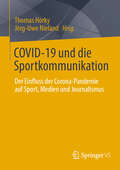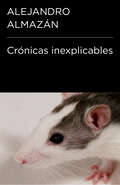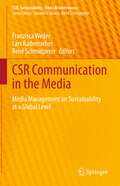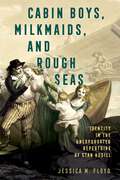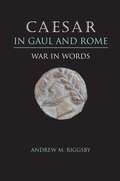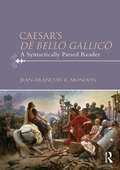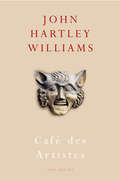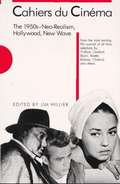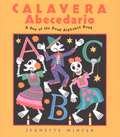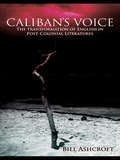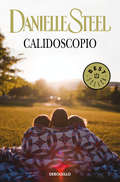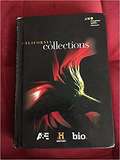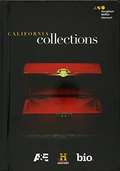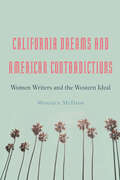- Table View
- List View
COVID-19 und die Sportkommunikation: Der Einfluss der Corona-Pandemie auf Sport, Medien und Journalismus
by Jörg-Uwe Nieland Thomas HorkyCOVID-19 hat die Sportkommunikation nachhaltig verändert. Der Band bietet empirische Analysen, Einschätzungen und theoretische Ansätze sowie Erfahrungsberichte aus der Praxis zum Einfluss der Corona-Pandemie auf Medien, Journalismus und Sport. Aus unterschiedlichen Perspektiven schauen Wissenschaftlerinnen und Wissenschaftler sowie Personen aus der Praxis auf die Veränderungen in verschiedenen Medien- und Sportorganisationen sowie den Wandel von Produktions- und Arbeitsbedingungen innerhalb der Sportkommunikation. Gleichzeitig lassen sich erste Prognosen für einen Ausblick auf die Zukunft des Mediensports ableiten.
CRONICAS INEXPLICABLES
by Alejandro AlmazánUn fantástico libro de crónicas por Alejandro Almazán, autor de El más buscado. Por estas páginas desfilan un narco sin suerte: Jota Erre, quien luego de seis intentos (fallidos) de incursionar en el negocio del siglo, decidió dedicarse a la cantada; las ratas gigantes de Atascaderos, Chihuahua, que aún asuelan a la población y que las autoridades siguen ignorando; los 200 mil dólares que Margarito "encontró" en el cerro y que le valieron la ruina; el exorcismo que en el año 2000 dejara un saldo de siete muertos y 70 mil incógnitas en una pequeña población de Tlaxcala. Acérquese. Adéntrese en estas historias. Inexplicables, escritas por uno de los mejores cronistas mexicanos de la actualidad.
CSR Communication in the Media: Media Management on Sustainability at a Global Level (CSR, Sustainability, Ethics & Governance)
by Lars Rademacher René Schmidpeter Franzisca WederCorporate social responsibility (CSR) is an established management focus of today's companies and organizations of different types, scope and size. Communication practices on CSR and sustainability in the media industry, related theoretical concepts, and empirical foundations have not yet been sufficiently explored. This book focuses on a new normative framework of sustainability, bridging the established debate on public value with the current debate on social impact and the social license to operate in the media industry. With a variety of contributions from theory and practice, the book addresses the dual nature of media and media companies, which simultaneously produce economic and cultural goods and thus bear a "double responsibility": on the one hand, for the way they present reality, monitor and criticize economic and political developments, and bring ethical concerns to the public debate. On the other hand, they bear responsibility for their own activities as companies (license to operate). The book is therefore aimed at readers interested in the journalistic perspective and at executives in the media industry.
Cabin Boys, Milkmaids, and Rough Seas: Identity in the Unexpurgated Repertoire of Stan Hugill
by Jessica M. FloydDuring his correspondence with erotic folklore collector Gershon Legman, famed chantey singer and collector Stan Hugill (1906–1992) shared unexpurgated versions of the songs in his repertoire. These bawdy songs were meant to be a part of Legman’s larger project concerning erotic folksong. Upon Legman’s death in 1999, the unfinished and unpublished manuscript sank into obscurity and was believed by many to be permanently lost. Thankfully this “holy grail” of chantey texts had been safe in the private collection of Legman’s widow, Judith Legman, all along. Cabin Boys, Milkmaids, and Rough Seas: Identity in the Unexpurgated Repertoire of Stan Hugill is the first critical investigation of this repository, reproduced here for the first time. Training an interdisciplinary lens on twenty-four unexpurgated texts, author Jessica M. Floyd interrogates the articulation of gender, sexuality, and identity as it is expressed in these cultural artifacts of the sea. Opening with both a critical explication of the chantey genre, as well as situating Hugill’s repertoire in the canon of folksong, the book introduces readers to the critical realities that attend this rich cultural tradition. Analytical chapters demonstrate the kaleidoscopic representation of gender and sexuality in this finite repertoire. Each inquiry is connected and overlapping, demonstrating an ebb and flow not unlike the waters on which the songs were sung. Words of warning, heteronormative economies, and queer undercurrents each collide to present an image of sailing life that is nuanced and complicated, provocative and evocative, transgressive and sometimes radical. The volume allows scholars to place a finger on the pulse of maritime life, feeling and experiencing one voice among the din of working-class song traditions.
Cacaphonies: The Excremental Canon of French Literature
by Annabel L. KimExploring why there is so much fecal matter in literary works that matterCacaphonies takes fecal matter and its place in literature seriously. Readers and critics have too long overlooked excrement&’s vital role in the twentieth- and twenty-first-century French canon. In a stark challenge to the tendency to view this literature through sanitizing abstractions, Annabel L. Kim undertakes close readings of key authors to argue for feces as a figure of radical equality, both a literary object and a reflection on literature itself, without which literary studies is impoverished and sterile. Following the fecal through line in works by Céline, Beckett, Genet, Sartre, Duras, and Gary and the contemporary authors Anne Garréta and Daniel Pennac, Kim shows that shit, far from vanishing from the canon after the early modern period, remains present in the modern and contemporary French literature that follows. She argues that all the shit in the canon expresses a call to democratize literature, making literature for all, just as shit is for (or of) all. She attends to its presence in this prized element of French identity, treating it as a continually uttered desire to manifest the universality France aspires to—as encapsulated by the slogan Liberté, égalité, fraternité—but fails to realize. In shit there is a concrete universalism that traverses bodies with disregard for embodied differences. Cacaphonies reminds us that literature, and the ideas to be found therein, cannot be separated from the corporeal envelopes that create and receive them. In so doing, it reveals the aesthetic, political, and ethical potential of shit and its capacity to transform literature and life.
Caddy Compson (Major Literary Characters)
by Harold BloomThe character of Caddy Compson, a major character in Faulkner's work is carefully examined.
Caesar in Gaul and Rome: War in Words
by Andrew M. RiggsbyAnyone who has even a passing acquaintance with Latin knows “Gallia est omnis divisa in partes tres” (“All Gaul is divided into three parts”), the opening line of De Bello Gallico, Julius Caesar's famous commentary on his campaigns against the Gauls in the 50s BC. But what did Caesar intend to accomplish by writing and publishing his commentaries, how did he go about it, and what potentially unforeseen consequences did his writing have? These are the questions that Andrew Riggsby pursues in this fresh interpretation of one of the masterworks of Latin prose. Riggsby uses contemporary literary methods to examine the historical impact that the commentaries had on the Roman reading public. In the first part of his study, Riggsby considers how Caesar defined Roman identity and its relationship to non-Roman others. He shows how Caesar opens up a possible vision of the political future in which the distinction between Roman and non-Roman becomes less important because of their joint submission to a Caesar-like leader. In the second part, Riggsby analyzes Caesar's political self-fashioning and the potential effects of his writing and publishing the Gallic War. He reveals how Caesar presents himself as a subtly new kind of Roman general who deserves credit not only for his own virtues, but for those of his soldiers as well. Riggsby uses case studies of key topics (spatial representation, ethnography, virtus and technology, genre, and the just war), augmented by more synthetic discussions that bring in evidence from other Roman and Greek texts, to offer a broad picture of the themes of national identity and Caesar's self-presentation.
Caesar's English 1
by Michael Thompson Myriam ThompsonThe book has about twenty lessons, each introducing five new stems with an introductory Latin Stem List and other learning activities.
Caesar’s Dē Bellō Gallicō: A Syntactically Parsed Reader
by Jean-François R. Mondon<p>Caesar’s Dē Bellō Gallicō: A Syntactically Parsed Reader is an innovative Latin reader presenting selections of Caesar’s Gallic wars texts. Its unique approach tackles the two most common problems a student reading unedited Latin faces: abundant vocabulary and a maze-like sentence structure. Breaking down the sentence structure of the texts and providing vocabulary glosses throughout, A Syntactically Parsed Reader ensures better comprehension and enables students to make an easier transition from using artificial and doctored Latin to working with the unaltered language found in authentic texts. <p>Features include: <p> <li>Texts presented with the syntactically parsed Latin on one page and vocabulary glosses on the other <li>Visual display of the syntactic structure of each Latin sentence throughout, with main clauses touching the left margin, subordinate clauses shown indented, and multiple subordinate clauses arranged to illustrate which clauses are dependent on which other clauses <li>Helpful grammar notes provided alongside the texts <li>High frequency vocabulary included in a separate appendix to encourage efficient vocabulary acquisition <li>Selected texts carefully chosen in line with the Advanced Placement Latin exam. </li> <p> <p>Caesar’s Dē Bellō Gallicō: A Syntactically Parsed Reader has been developed by an experienced university instructor. It is ideal for students seeking to improve their ability to read and understand Latin prose straight from the page.</p>
Café des Artistes
by John Hartley WilliamsWelcome to the Café des Artistes. Your host, the owner, bartender, master of ceremonies and only other guest: John Hartley Williams. Here you will be entertained and diverted - by bizarre stories of mapless roads and unreal cities, the Ostrich Palisades and the erotic stones of Bonehenge; by a spooked version of Rimbaud's 'La Bateau Ivre'; by encounters with Malcolm Lowry, the floating dead, the 'old men behind the waterfall' and the knitted poet; by poems about donkey jackets and dancing with donkeys, and a one-sided conversation with a decidedly un-Romantic polar bear two doors down from Dove Cottage.Long celebrated for his ranging, restless imagination, his baroque, elliptical narratives, his manic humour and maverick stance, Williams returns with another invitation to join him for a jug or two of wine in his out-of-kilter universe: a world that is both strange, and strangely familiar. Welcome to the Café des Artistes!
Cahiers du Cinéma: The 1950s Neo-Realism Hollywood New Wave
by Jim HillierThe selections in this volume are drawn from the colorful first decade of Cahiers, 1951-1959, when a group of young iconoclasts racked the world of film criticism with their provocative views an international cinema--American, Italian, and French in particular.
Cake Wrecks: When Professional Cakes Go Hilariously Wrong
by Jen YatesNew York Times Bestseller: Stories and photos of confectionary calamities that “will have you laughing so hard you’ll forget to eat” (The Washington Post).Have your cake and laugh at it, too, with the sweet treat known as Cake Wrecks: When Professional Cakes Go Hilariously Wrong. From the creator of the award-winning blog, here are the worst cakes ever, including the ugly, the silly, the downright creepy, the unintentionally sad or suggestive, and the just plain funny. With witty commentary and behind-the-scenes tidbits, Cake Wrecks will ensure that you never look at a cake the same way again.Jen Yates’ CakeWrecks site was a winner of a Blogger’s Choice Award for Best Humor Blog, among other honors, and for this inspired and sidesplitting collection, she gathered extensive never-before-seen material to create “a hilarious winner” (The Oregonian).“I haven’t laughed so hard in ages.” —Mary Alice, from the Food Network’s Ace of Cakes“Think of them as epic fails, with frosting.” —TheNew York Times
Cake Wrecks: When Professional Cakes Go Hilariously Wrong
by Jen YatesNew York Times Bestseller: Stories and photos of confectionary calamities that “will have you laughing so hard you’ll forget to eat” (The Washington Post).Have your cake and laugh at it, too, with the sweet treat known as Cake Wrecks: When Professional Cakes Go Hilariously Wrong. From the creator of the award-winning blog, here are the worst cakes ever, including the ugly, the silly, the downright creepy, the unintentionally sad or suggestive, and the just plain funny. With witty commentary and behind-the-scenes tidbits, Cake Wrecks will ensure that you never look at a cake the same way again.Jen Yates’ CakeWrecks site was a winner of a Blogger’s Choice Award for Best Humor Blog, among other honors, and for this inspired and sidesplitting collection, she gathered extensive never-before-seen material to create “a hilarious winner” (The Oregonian).“I haven’t laughed so hard in ages.” —Mary Alice, from the Food Network’s Ace of Cakes“Think of them as epic fails, with frosting.” —TheNew York Times
Cake Wrecks: When Professional Cakes Go Hilariously Wrong
by Jen YatesNew York Times Bestseller: Stories and photos of confectionary calamities that “will have you laughing so hard you’ll forget to eat” (The Washington Post).Have your cake and laugh at it, too, with the sweet treat known as Cake Wrecks: When Professional Cakes Go Hilariously Wrong. From the creator of the award-winning blog, here are the worst cakes ever, including the ugly, the silly, the downright creepy, the unintentionally sad or suggestive, and the just plain funny. With witty commentary and behind-the-scenes tidbits, Cake Wrecks will ensure that you never look at a cake the same way again.Jen Yates’ CakeWrecks site was a winner of a Blogger’s Choice Award for Best Humor Blog, among other honors, and for this inspired and sidesplitting collection, she gathered extensive never-before-seen material to create “a hilarious winner” (The Oregonian).“I haven’t laughed so hard in ages.” —Mary Alice, from the Food Network’s Ace of Cakes“Think of them as epic fails, with frosting.” —TheNew York Times
Calavera Abecedario: A Day Of The Dead Alphabet Book
by Jeanette WinterEvery year Don Pedro and his family make papier-mâché skeletons, or calaveras, for Mexico's Day of the Dead fiesta. From the Angel and Doctor to the Mariachi and Unicornio, there's a special calavera for each letter of the alphabet. Come dance with them!Includes a glossary of Spanish words and an author's note.
Caliban's Voice: The Transformation of English in Post-Colonial Literatures
by Bill AshcroftIn Shakespeare’s Tempest, Caliban says to Miranda and Prospero: "...you taught me language, and my profit on’t Is, I know how to curse. " With this statement, he gives voice to an issue that lies at the centre of post-colonial studies. Can Caliban own Prospero’s language? Can he use it to do more than curse? Caliban’s Voice examines the ways in which post-colonial literatures have transformed English to redefine what we understand to be ‘English Literature’. It investigates the importance of language learning in the imperial mission, the function of language in ideas of race and place, the link between language and identity, the move from orature to literature and the significance of translation. By demonstrating the dialogue that occurs between writers and readers in literature, Bill Ashcroft argues that cultural identity is not locked up in language, but that language, even a dominant colonial language, can be transformed to convey the realities of many different cultures. Using the figure of Caliban, Ashcroft weaves a consistent and resonant thread through his discussion of the post-colonial experience of life in the English language, and the power of its transformation into new and creative forms.
Calidoscopio
by Danielle SteelUn terrible suceso trunca la vida de las tres hermanas Walker, separadas en la infancia y entregadas en adopción a distintas familias. Pero Hilary, la mayor y menos afortunada de las tres, preservará en su memoria su vida en común y alentará durante años la esperanza de, finalmente, volver a reunirse con ellas.
California Collections
by Houghton Mifflin HarcourtCalifornia Collections: A Grade 9 language arts textbook
California Collections, Grade 7
by Houghton Mifflin Harcourt StaffCalifornia Collections, Grade 7 a language arts textbook by Houghton Mifflin Harcourt.
California Dreams and American Contradictions: Women Writers and the Western Ideal
by Monique McDadeCalifornia Dreams and American Contradictions establishes a genealogy of western American women writers publishing between 1870 and 1965 to argue that both white women and women of color regionalized dominant national literary trends to negotiate the contradictions between an American liberal individualism and American equality. Monique McDade analyzes works by María Amparo Ruiz de Burton, Helen Hunt Jackson, Sui Sin Far, and a previously unstudied African American writer, Eva Rutland, to trace an archive of western American women writers who made visible what dominant genres subsumed under images of American progress and westward expansion. Read together these writers provide new entry points into the political debates that have plagued the United States since the nation&’s founding and that set the precedent for westward expansion. Their romances, regional sketches, memoirs, and journalism point to the inherently antagonistic relationship between a Rooseveltian rugged individualism that encouraged an Anglo male–dominated West and the progressive equality and opportunity the West seemingly promised disenfranchised citizens. The writers included in California Dreams and American Contradictions challenged literature&’s role in creating regional division, conformist communities that support nationally sponsored images of gendered, ethnic, and immigrant others, and liberal histories validated through a strategic vocabulary rooted in &“freedom,&” &“equality,&” and &“progress.&”
California Gateways [Anthology, Level 1B]
by Isabel L. Beck Margaret Mckeown Robin ScarcellaNIMAC-sourced textbook
California McDougal Littell Literature: American Literature
by Mcdougal LittellA language arts textbook
California My Perspectives English Language Arts, Grade 9, Volume Two
by PearsonCalifornia My Perspectives English Language Arts, Grade 9, Volume Two
